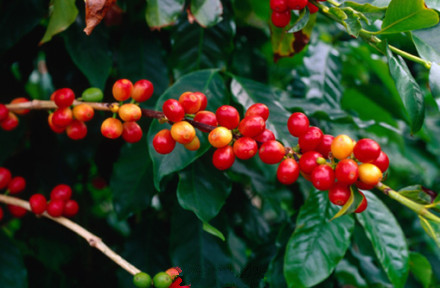The picking of coffee beans coffee beans are the seeds of coffee trees.
Coffee beans are the seeds of coffee trees. After 3-4 years of growth, the coffee tree matures and begins to bear fruit, one by one, in clusters or clusters along the branches. The seed is covered with a peel that can be picked as soon as it turns red. Below the red skin (exocarp) is a layer of flesh (mesocarp), inside which is a small thin layer, and further inside is a layer of parchment-like material-endocarp. Inside all these skins there are usually two flat opposed beans with a thin film or skin on the outside. Most Arabica beans mature between June and August, while Robett beans mature between September and October. Therefore, although in some countries where the dry and wet seasons are not obvious, such as Colombia and Kenya, there are two flowering times a year, that is, there are two harvests, but strictly speaking, there is only one year. Harvest times vary from region to region. Areas north of the equator (e.g. Ethiopia and Central America) typically harvest 9-11 crops. South of the equator, in areas such as Brazil and Zimbabwe, the main harvest occurs in April or May, although it can last until August. Equatorial countries, such as Uganda and Colombia, harvest year-round, especially plantations that exploit a variety of altitudes. As a result, coffee beans may be newly harvested most of the year. As far as picking itself is concerned, there are two ways: bulk picking, which means that all the beans are picked in one trip through the garden, and selective picking, which means that several trips between the trees are made at intervals of 8-10 days and only the ripe red berries are picked. Selective picking is more expensive and labour-intensive than piecing, and is generally used only for arabica beans, especially those that need to be washed. The amount of coffee beans picked depends on many factors, most notably the height of the trees and the layout of the farm or plantation. On average, each picker can pick 50-100 kilograms a day. But only 20% of that weight is real coffee beans, so the average picker can only pick 10-20 kilograms of coffee beans. Coffee beans are packed in bags with a standard weight of 45-60 kg. Therefore, it takes a worker 3-6 days to fill a bag. It has been calculated that the cost of harvesting a plantation or farm is half the total cost of the whole year. In Brazil, mechanical harvesting has been tried several times to reduce these costs. The machine shakes branches astride coffee trees so that berries loose from ripeness fall into funnels. Mechanical pickers are only suitable in areas where natural conditions are better, and they need to be adjusted beforehand, because they can only be used where the rows of trees can be straightened very straight, and afterwards the beans picked by the machine need to be inspected and the leaves and branches dropped into the hopper removed. So much of the coffee is picked by hand, which requires a lot of seasonal labor, and pickers have to be careful not to pick underripe, bad, or overripe beans because they affect the overall quality of the coffee harvested. Coffee beans that are no longer good are classified as normal, sour or fermented, with the last category being extremely poor.

Important Notice :
前街咖啡 FrontStreet Coffee has moved to new addredd:
FrontStreet Coffee Address: 315,Donghua East Road,GuangZhou
Tel:020 38364473
- Prev

The difference between several Common Coffee Colombian Coffee
From ordinary brewing technology to advanced brewing technology, from single taste to unique taste. Here are some common types of coffee. Blue Mountain Coffee: blue Mountain Coffee has all the characteristics of good coffee, not only full-bodied and mellow, but also its bitter, sour and sweet taste is perfect, so Blue Mountain Coffee is generally drunk as a single product. The output of this kind of coffee is very small, and the price is incomparably high, so it is on the market.
- Next

China will become the largest coffee consumer in the world
Experts estimate that China will become the largest coffee consumer in the world. By 2020, if China drinks one cup of coffee per person per day, the coffee bean market alone will reach 50 billion US dollars a year, and the entire industry will generate a market of hundreds of billions of US dollars. The popularization of coffee has become a must. Through the eight cities of Beijing, Shanghai, Guangzhou, Chengdu, Chongqing, Hangzhou and Nanjing.
Related
- Detailed explanation of Jadeite planting Land in Panamanian Jadeite Manor introduction to the grading system of Jadeite competitive bidding, Red bid, Green bid and Rose Summer
- Story of Coffee planting in Brenka region of Costa Rica Stonehenge Manor anaerobic heavy honey treatment of flavor mouth
- What's on the barrel of Blue Mountain Coffee beans?
- Can American coffee also pull flowers? How to use hot American style to pull out a good-looking pattern?
- Can you make a cold extract with coffee beans? What is the right proportion for cold-extracted coffee formula?
- Indonesian PWN Gold Mandrine Coffee Origin Features Flavor How to Chong? Mandolin coffee is American.
- A brief introduction to the flavor characteristics of Brazilian yellow bourbon coffee beans
- What is the effect of different water quality on the flavor of cold-extracted coffee? What kind of water is best for brewing coffee?
- Why do you think of Rose Summer whenever you mention Panamanian coffee?
- Introduction to the characteristics of authentic blue mountain coffee bean producing areas? What is the CIB Coffee Authority in Jamaica?

